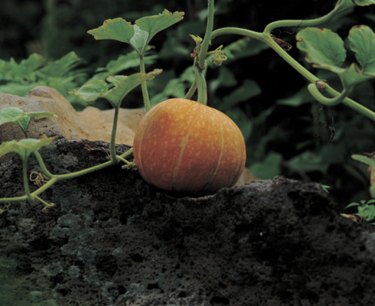
Few vegetable crops are as fun to grow as whimsical, cheery pumpkins. Although pumpkins are subject to many diseases, most home gardeners can bring a crop to maturity with few problems. If pumpkins turn yellow and die off, though, consider disease or insect infestations as likely suspects. The problem may not be treatable during the current growing season, but proper identification can minimize issues in the future.
Disease
Video of the Day
Pumpkin vines are subject to several diseases, such as powdery mildew, bacterial wilt, Phytophthora blight and cucumber mosaic virus. Most of these diseases attack the leaves and vines first. Powdery mildew, for example, causes a powdery, white growth on the leaves and vines. As the disease progresses, it may affect the fruit directly, or in most cases, causes the vines to collapse, resulting in yellowed, rotting fruit. County extension offices can positively identify disease problems and offer solutions. Some diseases respond to treatments of fungicide, while others are untreatable.
Video of the Day
Insects
Insects can cause serious damage to pumpkins, not only because they feed on the vines, leaves and fruit, but because they spread disease. Squash vine borers are the larva of a wasplike moth and enter the vines in early summer. They bore through the vines, causing them to collapse and any ripening fruit to yellow and rot. Aphids suck the juices out of pumpkin vines, causing them to wilt. They also spread cucumber mosaic virus, which causes pumpkins to yellow. Striped cucumber beetles damage pumpkins directly and also spread bacterial wilt. Hand pick striped cucumber beetles and treat aphids and squash vine borers with pesticides.
Growing Conditions
Unfavorable growing conditions may also cause pumpkins to turn yellow and die off. Lack of water causes leaves to wilt and droop. Plant growth slows and developing fruit may wither, turn yellow and die. Pumpkins are pollinated by honeybees that spread pollen from the male flowers to the female flowers. During cold, rainy weather, the flowers may not become pollinated, or may not become fully pollinated. Incomplete pollination can cause young pumpkin fruits to drop off. Cold weather in the fall kills the vines and leaves. Pumpkins remaining in the garden will fail to ripen and die, as well.
Recommendations
To ensure a healthy pumpkin patch, plant pumpkins in full sun, only after the last expected frost. Work 2 inches of compost or manure into the soil prior to planting to improve fertility and drainage. Control weeds and insect pests early to prevent the spread of disease and water the soil as needed to keep it evenly moist, but not soggy. Hand-pollinate pumpkins during an extended period of cold weather by brushing male flowers with a paint brush. Brush the insides of female flowers, identified by a bump at the base of the fruit, to release the pollen and pollinate the flower. Harvest pumpkins before the first heavy frost. Rotate crops annually so pumpkins don't grow in the same location each year.